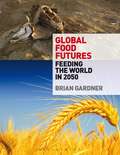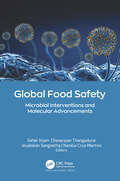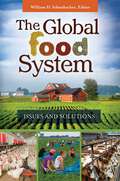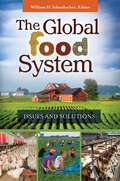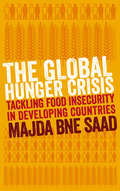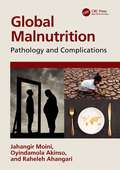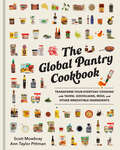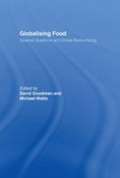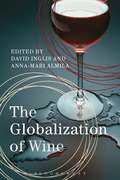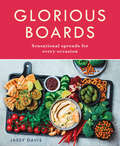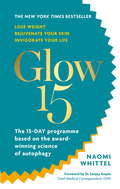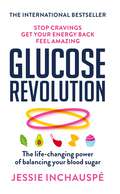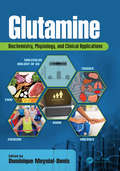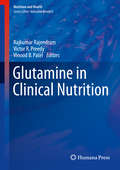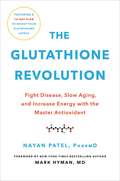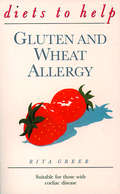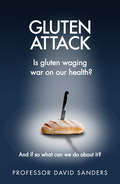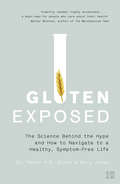- Table View
- List View
Global Food Futures: Feeding the World in 2050
by Brian GardnerBy 2050 the world will be faced with the enormous challenge of feeding 9 billion people despite being affected by climate change, rising energy costs and pressure on food growing land and other major resources. How will the world produce 70% more food by 2050 to feed a projected extra 2.3 billion people? What will be the impact of food shortages and high prices on areas in crisis such as sub-Sahara Africa? Where will future production growth come from? And how do we balance the need for environmental protection with sustainable agricultural production methods? This is the first text to present a scholarly, balanced approach to the contentious area of food production and supply up to 2050 - offering a readable and well-informed account which tackles the global food situation in all its totality, from agricultural production, technological advance, dietary concerns, population changes, income trends, environmental issues, government food and agriculture policy, trade, financial markets, macroeconomics and food security. Highly accessible and written by a specialist author with experience as an agricultural analyst, policy advisor and researcher, Global Food Futures synthesises the key issues in one volume.
Global Food Safety: Microbial Interventions and Molecular Advancements
by Saher Islam Devarajan Thangadurai Jeyabalan Sangeetha Natália Cruz-MartinsFoodborne microbial outbreaks are a serious food safety and public health concern worldwide. One of the most challenging issues in food safety is the identification and characterization of foodborne microbial communities, which is a core objective of research by food scientists and food microbiologists. This book reviews the molecular advances in food science related to the safety and quality of food along with recent diagnostic tools for the detection of emerging pathogens based on the food commodities. It presents a wide selection of methods for the identification and characterization of foodborne infectious agents. This book provides an overview of foodborne pathogens, diseases, and outbreaks and then proceeds to delve into techniques for characterizing foodborne pathogens using molecular approaches. It reviews state-of-the-art methods for detecting and tracing foodborne pathogens using next-generation sequencing and whole-genome sequencing for controlling foodborne illnesses as well as the application of microorganisms in food production for preventing foodborne illnesses. The book ends with an overview of management systems and analytical tools for public health protection from foodborne illnesses.
Global Food Safety: Microbial Interventions and Molecular Advancements
by Saher Islam Devarajan Thangadurai Jeyabalan Sangeetha Natália Cruz-MartinsFoodborne microbial outbreaks are a serious food safety and public health concern worldwide. One of the most challenging issues in food safety is the identification and characterization of foodborne microbial communities, which is a core objective of research by food scientists and food microbiologists. This book reviews the molecular advances in food science related to the safety and quality of food along with recent diagnostic tools for the detection of emerging pathogens based on the food commodities. It presents a wide selection of methods for the identification and characterization of foodborne infectious agents. This book provides an overview of foodborne pathogens, diseases, and outbreaks and then proceeds to delve into techniques for characterizing foodborne pathogens using molecular approaches. It reviews state-of-the-art methods for detecting and tracing foodborne pathogens using next-generation sequencing and whole-genome sequencing for controlling foodborne illnesses as well as the application of microorganisms in food production for preventing foodborne illnesses. The book ends with an overview of management systems and analytical tools for public health protection from foodborne illnesses.
The Global Food System: Issues and Solutions
by William D. SchanbacherThis detailed analysis of the global food system looks at the way food is produced, distributed, and consumed in an effort to create a more equitable and healthful system worldwide.With large-scale famine afflicting regions around the globe and overconsumption and unhealthy eating habits destroying others, many are beginning to wonder if access to food is less of a class-based social problem and more of an ethical issue affecting the lives—and livelihoods—of people all over the world. This thoughtful text provides a thorough examination of the factors contributing to this global concern, exploring the complexities of international food supply and demand as well as the efforts to bring about a more just global food system.Through this groundbreaking volume, author and educator Will Schanbacher sheds light on flaws in the current structure and suggests ways to achieve a more balanced approach. He considers the economics, politics, and activism behind and involved in the production, distribution, and consumption of the global food system. In an effort to illuminate many problems associated with hunger, inequality, and injustice in the food system, the book also offers many potential strategies and solutions for making a more healthy, sustainable, and equitable world. Chapters contain both theoretical models and concrete practices for food security and offer strategies for creating an equitable system.
The Global Food System: Issues and Solutions
by William D. Schanbacher, EditorThis detailed analysis of the global food system looks at the way food is produced, distributed, and consumed in an effort to create a more equitable and healthful system worldwide.With large-scale famine afflicting regions around the globe and overconsumption and unhealthy eating habits destroying others, many are beginning to wonder if access to food is less of a class-based social problem and more of an ethical issue affecting the lives—and livelihoods—of people all over the world. This thoughtful text provides a thorough examination of the factors contributing to this global concern, exploring the complexities of international food supply and demand as well as the efforts to bring about a more just global food system.Through this groundbreaking volume, author and educator Will Schanbacher sheds light on flaws in the current structure and suggests ways to achieve a more balanced approach. He considers the economics, politics, and activism behind and involved in the production, distribution, and consumption of the global food system. In an effort to illuminate many problems associated with hunger, inequality, and injustice in the food system, the book also offers many potential strategies and solutions for making a more healthy, sustainable, and equitable world. Chapters contain both theoretical models and concrete practices for food security and offer strategies for creating an equitable system.
The Global Hunger Crisis: Tackling Food Insecurity in Developing Countries
by Majda Bne SaadFor billions across the world, the daily challenge is to find enough to eat to survive. Hunger is on the rise globally with more than 1.2 billion people suffering from food insecurity and poverty and rising food prices increasingly jeopardising access to food. But what are the causes for global hunger? And as the global population soars, what are the key food challenges? *BR**BR*In this deeply informative study, Majda Bne Saad identifies the causes for global hunger which are embedded in the current economic system, apportioning blame for global hunger on the West's continuing support for and subsidies to biofuels, which have created persistent and formidable new demands for food commodities. Saad proposes we fight-back, arguing for a 'second green revolution' to grow more food and by analysing the factors constraining low-income nations from achieving food security, she considers policies which could generate income and enhance individuals' entitlement to food. *BR**BR*
The Global Hunger Crisis: Tackling Food Insecurity in Developing Countries
by Majda Bne SaadFor billions across the world, the daily challenge is to find enough to eat to survive. Hunger is on the rise globally with more than 1.2 billion people suffering from food insecurity and poverty and rising food prices increasingly jeopardising access to food. But what are the causes for global hunger? And as the global population soars, what are the key food challenges? *BR**BR*In this deeply informative study, Majda Bne Saad identifies the causes for global hunger which are embedded in the current economic system, apportioning blame for global hunger on the West's continuing support for and subsidies to biofuels, which have created persistent and formidable new demands for food commodities. Saad proposes we fight-back, arguing for a 'second green revolution' to grow more food and by analysing the factors constraining low-income nations from achieving food security, she considers policies which could generate income and enhance individuals' entitlement to food. *BR**BR*
Global Malnutrition: Pathology and Complications
by Jahangir Moini Oyindamola Akinso Raheleh AhangariGlobal Malnutrition: Pathology and Complications addresses various types of malnutrition including deficiencies (undernutrition), excesses (overnutrition), and imbalances in a person's intake of nutrients. Malnutrition is considered a global health crisis causing various types of chronic diseases in humans. Malnutrition is very serious when affecting children as the result can be a lifetime of serious health problems. This book addresses the importance of combating undernutrition and overnutrition. It discusses the prevalence of nutritional disorders and epidemics; assesses nutritional requirements for various populations; and focuses on special populations most affected by nutritional disorders. Features: · Covers various diseases caused by poor diet and nutrition · Provides suggestions on preventing malnutrition by improving diet and nutrition · Discusses nutritional disorders and epidemics · Presents information on nutritional requirements in special populations · Contains clinical case studies with critical thinking questions and answers, clinical treatments, and costs Featuring an engaging writing style and excellent flow of material, Global Malnutrition: Pathology and Complications contains practical applications for use in clinical practice. It includes suggestions for improving diet and nutrition in order to prevent malnutrition. Figures enhance content, and questions at the end of the chapters with corresponding answers at the end of the book reinforce the subject matter.
Global Malnutrition: Pathology and Complications
by Jahangir Moini Oyindamola Akinso Raheleh AhangariGlobal Malnutrition: Pathology and Complications addresses various types of malnutrition including deficiencies (undernutrition), excesses (overnutrition), and imbalances in a person's intake of nutrients. Malnutrition is considered a global health crisis causing various types of chronic diseases in humans. Malnutrition is very serious when affecting children as the result can be a lifetime of serious health problems. This book addresses the importance of combating undernutrition and overnutrition. It discusses the prevalence of nutritional disorders and epidemics; assesses nutritional requirements for various populations; and focuses on special populations most affected by nutritional disorders. Features: · Covers various diseases caused by poor diet and nutrition · Provides suggestions on preventing malnutrition by improving diet and nutrition · Discusses nutritional disorders and epidemics · Presents information on nutritional requirements in special populations · Contains clinical case studies with critical thinking questions and answers, clinical treatments, and costs Featuring an engaging writing style and excellent flow of material, Global Malnutrition: Pathology and Complications contains practical applications for use in clinical practice. It includes suggestions for improving diet and nutrition in order to prevent malnutrition. Figures enhance content, and questions at the end of the chapters with corresponding answers at the end of the book reinforce the subject matter.
The Global Pantry Cookbook: Transform Your Everyday Cooking with Tahini, Gochujang, Miso, and Other Irresistible Ingredients
by Scott Mowbray Ann Taylor PittmanTwo James Beard-Award winners show how to unlock the secrets of the global pantry and elevate all your favorite foodsMake the most succulent pot roast ever with oyster sauce. Transform a broiled salmon filet with miso. Give an irresistible kick to chicken wings with gochujang. Turn out the crunchiest French toast with panko breadcrumbs. Use Mexican chorizo to add depth to a quick skillet chili. Enliven a no-churn ice cream pie with freeze-dried berries. Impart a savory kick to shrimp and grits with sambal oelek. Add coconut milk to banana pudding—it&’s magical. And even your best ribs will take on a sticky new deliciousness with sweet soy sauce. In more than 120 recipes, here&’s how—with just a dash here or a tablespoon there—you can elevate your cooking using 65 common pantry items from around the world.
Globalising Food: Agrarian Questions And Global Restructuring (PDF)
by David Goodman Michael WattsIn an increasingly global world, societies are being provisioned from a bewildering array of sources as new countries and new food commodities are drawn into international markets. Globalising Foodprovides an innovative contribution to the area of political economy of agriculture, food and consumption through a revealing investigation of the globalisation and restructuring of localised agricultural sectors and food systems. The book draws on new theoretical perspectives and wide-ranging case studies from Britain, the USA, India, South Africa, New Zealand and Latin America. The key themes addresses range from giant multinational food corporations, rural industrialisation and World Bank policies, to the regulation of pollution, labour relations, urban food politics and environmental sustainability. Globalising Foodoffers important insights into the problems, consequences and limits of the industrialisation of agriculture and the provisioning of food in a global world as we approach the new millenium.
Globalising Food: Agrarian Questions and Global Restructuring
by David Goodman Michael WattsIn an increasingly global world, societies are being provisioned from a bewildering array of sources as new countries and new food commodities are drawn into international markets. Globalising Foodprovides an innovative contribution to the area of political economy of agriculture, food and consumption through a revealing investigation of the globalisation and restructuring of localised agricultural sectors and food systems. The book draws on new theoretical perspectives and wide-ranging case studies from Britain, the USA, India, South Africa, New Zealand and Latin America. The key themes addresses range from giant multinational food corporations, rural industrialisation and World Bank policies, to the regulation of pollution, labour relations, urban food politics and environmental sustainability. Globalising Foodoffers important insights into the problems, consequences and limits of the industrialisation of agriculture and the provisioning of food in a global world as we approach the new millenium.
The Globalization of Wine
by David Inglis Anna-Mari AlmilaThe Globalization of Wine is a one-stop guide to understanding wine across the world today. Examining a broad range of developments in the wine world, it considers the social, cultural, economic, political and geographical dimensions of wine globalization. It investigates how large-scale changes in production, distribution and consumption are transforming the wine that we drink. Comprehensive background discussion is complemented by vivid case study chapters from a variety of international contributors. Many different countries and regions are covered, including China, the USA and Hong Kong, as are key themes, debates and controversies in contemporary wine worlds. Innovative, up-to-date and interdisciplinary, The Globalization of Wine illustrates the diversity and complexity of wine globalization processes across the planet, both in the past and at the present time. It is essential reading for academics and students in food and drink studies, sociology, anthropology, globalization studies, geography and cultural studies. It also provides a jargon-free resource for wine professionals and connoisseurs.
The Globalization of Wine
The Globalization of Wine is a one-stop guide to understanding wine across the world today. Examining a broad range of developments in the wine world, it considers the social, cultural, economic, political and geographical dimensions of wine globalization. It investigates how large-scale changes in production, distribution and consumption are transforming the wine that we drink. Comprehensive background discussion is complemented by vivid case study chapters from a variety of international contributors. Many different countries and regions are covered, including China, the USA and Hong Kong, as are key themes, debates and controversies in contemporary wine worlds. Innovative, up-to-date and interdisciplinary, The Globalization of Wine illustrates the diversity and complexity of wine globalization processes across the planet, both in the past and at the present time. It is essential reading for academics and students in food and drink studies, sociology, anthropology, globalization studies, geography and cultural studies. It also provides a jargon-free resource for wine professionals and connoisseurs.
Glorious Boards: Sensational Spreads For Every Occasion
by Jassy DavisLearn how to assemble stunning grazing boards quickly and easily, with the mouth-watering photographs and simple recipes of Glorious Boards. Uncover the world of sharing boards and platters, featuring charcuterie spreads, cheese boards, and dessert decks for every occasion, theme, and celebration.
Glow: Your Complete Four-Week Plan for Healthy, Radiant Skin with 60 Skin-Nourishing Recipes
by Kate O'BrienIf you are frustrated by spending vast amounts of money on expensive skincare products that don’t deliver on their promise, Kate O’Brien’s easy four-week GLOW plan is a must.Kate’s tried-and-tested revitalising GLOW plan contains over 60 easy, skin-nourishing, plant-based recipes along with a targeted step-by-step skincare routine that separates skincare fact from fiction.Discover what works for your skin, whatever your age, from face oils, scrubs and serums to moisturisers, skin acids and an optimum sleep plan that will take years off your face. Kate’s gut-friendly GLOW foods are overflowing with the necessary nutrients that will keep your skin, gut and body vibrant, alive and glowing.Whether you have an upcoming wedding, a holiday or simply want to look and feel your best, this quick and easy plan puts you on the fast track to beautifully radiant skin.
Glow15: A Science-Based Plan to Lose Weight, Rejuvenate Your Skin & Invigorate Your Life
by Naomi WhittelTHE NEW YORK TIMES BESTSELLERIn addition to natural wear and tear that our bodies experience, environmental toxins accumulate in our cells, accelerating the signs of aging. Autophagy is the cellular process that removes these toxins and repairs the damage left behind. On GLOW15, you start each day with an autophagy-activating ketogenic tea and a light, full-fat breakfast, followed by intermittent fasting and protein cycling. You eat foods that activate autophagy - like dairy, red wine, grains and a blueberry smoothie.It can be that simple to see dramatic results in just 15 days - fast weight loss and glowing, radiant skin. You don't count calories. You don't give up entire food groups. And you don't obsess about the gym. You do, however, get Naomi Whittel's advice for sleep, travel, stress reduction and productivity, as well as delicious and nutritious recipes for eating the GLOW15 way - everything that this 42-year-old CEO and mother of four young children does to look and feel amazing.
Glucose Revolution: The life-changing power of balancing your blood sugar
by Jessie Inchauspe"Jessie (a.k.a. the Glucose Goddess) takes you on a fun and informative journey to understand how food affects your sugar spikes and your health. This practical guide is full of wonderful tips and hacks on how and what to eat; a must for anyone who wants to understand their body and improve their health." - Professor Tim Spector, author of Diet Myth and Spoon Fed, professor of genetic epidemiology at King's College, London"Glucose Revolution will help you feel better, cut cravings, connect with yourself, balance your hormones, live longer, teach you science and put a smile on your face along the way. This book is one of my references - don't wait to read it." - Davinia Taylor, British actor and #1 Sunday Times bestselling author of It's not a DietDietary science is on the move. For decades, people were wrongly focused on reducing fat and calories, whereas we now know that the real trouble-makers are the foods that deregulate our blood sugar levels.In writing both clear and empathetic, biochemist Jessie Inchauspé explains why blood sugar spikes are so bad for us and how to flatten those spikes to transform our health.By analysing decades of research and running thousands of original experiments on herself wearing a continuous glucose monitor, she has distilled 10 simple and surprising hacks that can be easily incorporated into everyday life.By the end of this book, you'll be aware of how food impacts your biology. You'll know which breakfast choices may be causing your cravings, in which order you should eat the food on your plate, what not to do on an empty stomach, which foods lead to mood swings, and how to avoid being sleepy at 3pm. You'll evolve the way you eat, take control of your health, and your life will flourish.
Glutamine: Biochemistry, Physiology, and Clinical Applications
by Dominique Meynial-DenisGlutamine: Biochemistry, Physiology, and Clinical Applications describes the different functions of glutamine (Gln) in animals and humans. Gln is both a nutrient and a signaling molecule, and its functions go beyond those of a simple metabolic fuel or protein precursor. This book has gathered together, in an unbiased and critical manner, all the available evidence and research on Gln including pathology (neurological diseases, intestinal diseases, critical illness, and cancer), physiology (successful aging), catabolic states, immunity, and exercise. Special attention is given to the potential benefit of Gln in states of insulin resistance and the role of Gln as a "conditionally essential" amino acid. The contributors are either pioneers or experts in the area of Gln from all around the globe, including Australia, Brazil, Canada, Europe, China, and the United States. This book is a valuable source of information for nutrition scientists, medical doctors, sports scientists, food scientists, dietitians, and anyone interested in nutrition. It is also a valuable resource for students in these fields and will be an important addition to university libraries.
Glutamine: Biochemistry, Physiology, and Clinical Applications
by Dominique Meynial-DenisGlutamine: Biochemistry, Physiology, and Clinical Applications describes the different functions of glutamine (Gln) in animals and humans. Gln is both a nutrient and a signaling molecule, and its functions go beyond those of a simple metabolic fuel or protein precursor. This book has gathered together, in an unbiased and critical manner, all the available evidence and research on Gln including pathology (neurological diseases, intestinal diseases, critical illness, and cancer), physiology (successful aging), catabolic states, immunity, and exercise. Special attention is given to the potential benefit of Gln in states of insulin resistance and the role of Gln as a "conditionally essential" amino acid. The contributors are either pioneers or experts in the area of Gln from all around the globe, including Australia, Brazil, Canada, Europe, China, and the United States. This book is a valuable source of information for nutrition scientists, medical doctors, sports scientists, food scientists, dietitians, and anyone interested in nutrition. It is also a valuable resource for students in these fields and will be an important addition to university libraries.
Glutamine in Clinical Nutrition (Nutrition and Health)
by Rajkumar Rajendram Victor R. Preedy Vinood B. PatelGlutamine is the most abundant amino acid and is a major contributor to whole body nitrogen metabolism and is considered to be “conditionally essential.” Glutamine in Health and Disease presents the application of current nutritional knowledge by physicians and dietitians and incorporates emerging fields of science and important discoveries. Section 1 covers glutamine structure and function, glutamine synthetase, glutamine binding protein, glutamine transport, glutamine-rich activation domains and transcription, glutamine transaminase and cell biochemistry. Section 2 covers glucose-independent glutamine metabolism, intestinal barrier function, thyroid-stimulating hormone, glutamine resonances, focal ischemia, plasma glutamine, metabolic stress, cancer and absorption. Section 3 covers dipeptide-bound glutamine, DNA protection, oxidative stress, NF-KB, the inflammatory response, the lung, kidney, GI tract and liver, autophagy, ethanol and diabetes. Finally, Section 4 covers the use of glutamine in preoperative states, enteral and parenteral nutrition, pulmonary infections, cancer, hypoxic injury, arginyl-glutamine, paediatrics, pancreatic surgery, the elderly, gastric emptying gastric bypass and use glutamine cocktails. Written by authors of international and national standing, leaders in the field and trendsetters, Glutamine in Health and Disease is essential reading for nutritionists and dietitians, public health scientists, physicians, epidemiologists, policy makers, and health care professionals of various disciplines.
The Glutathione Revolution: Fight Disease, Slow Aging, and Increase Energy with the Master Antioxidant
by Nayan PatelWard off life-threatening disease and symptoms of aging with this guide to boosting your levels of glutathione (GHS), the "master antioxidant."While there's no real fountain of youth just yet, upping your levels of glutathione (GHS) can help you ward off life-threatening disease and symptoms of aging. GSH is the disease-fighting, age-slowing, energy-enhancing, beautifying antioxidant that many of us are just starting to be aware of. It helps do everything from bolstering immunity to lowering inflammation and regulating hormones -- which means it has the potential to help protect against a long list of maladies (cancer, heart disease, diabetes, arthritis, and Alzheimer's).At the forefront of research, Dr. Nayan Patel offers the first book that really unpacks the power of this super antioxidant. The Glutathione Revolution is a guide that is both comprehensive and practical, outlining what exactly glutathione is -- and what happens to us as it decreases over time. Dr. Patel shows us how to naturally kick it into overdrive to capitalize on the antioxidant's innumerable benefits. With a 14-day plan, along with recipes, menus, and easy natural steps to boost glutathione levels in the body, you can feel younger and ward off the diseases of aging -- naturally.
Gluten and Wheat Allergy: Suitable For Those With Coeliac Disease (Diets to Help)
by Rita GreerThe incidence of coeliac disease is on the increase, especially amongst younger people. Allergies related to wheat and gluten plague many with digestive problems, allergy and mood swings.
Gluten Attack: Is Gluten waging war on our health? And if so what can we do about it?
by Prof. David SandersThe first entirely evidence-based guide revealing the truth about gluten.Gluten is regularly lambasted in the press, demonised by wellbeing experts and banned from more diets every day. But do we know why? Where does the hype end and science begin? And will bread forever be off the menu?Cutting through the sensationalism, myths and confusion surrounding all things gluten, Professor David Sanders is here to bring us the very latest evidence and groundbreaking research findings from his very personal journey into the heartland of Gluten. Including: · Specific advice tailored to suit individual needs, from coeliac to wheat-sensitive and FODMAP· A comprehensive look at how exactly gluten affects the body· Delicious gluten-free recipesThis book will help to advise you and empower you, both in terms of understanding the evidence and providing guidance about how best to look after yourself – whether gluten is for you or not.
Gluten Exposed: The Science Behind The Hype And How To Navigate To A Healthy, Symptom-free Life
by Dr. Peter Green Rory JonesFrom the internationally renowned expert on celiac disease and director of the Celiac Disease Center at Columbia University, here is the definitive book on gluten, uncovering the truth and explaining the science behind the current gluten-free craze.
